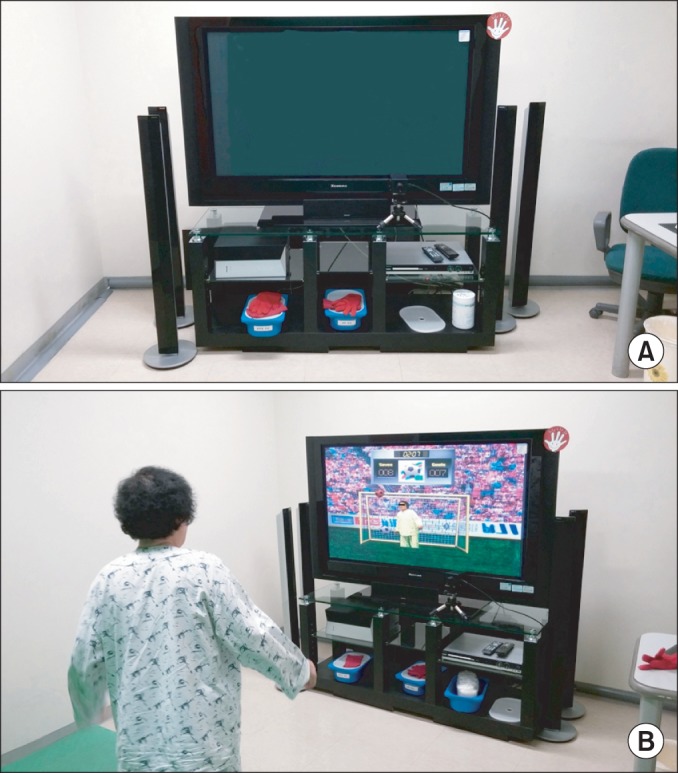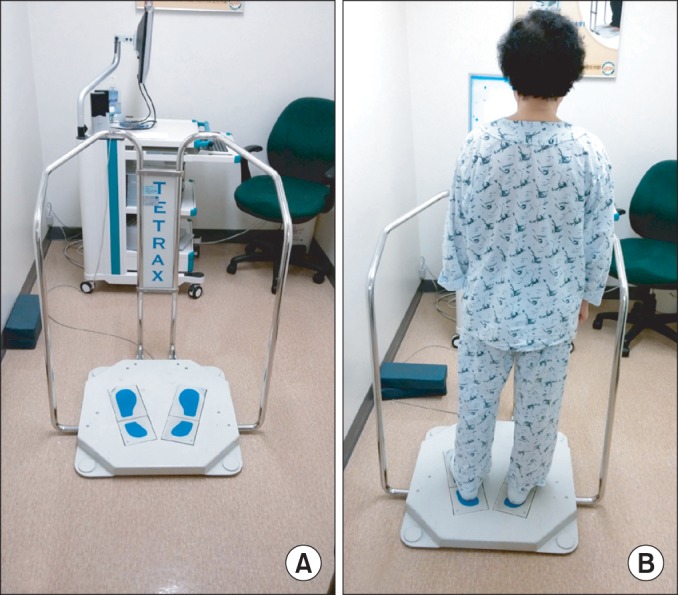Ann Rehabil Med.
2014 Apr;38(2):160-166.
The Effect of Virtual Reality and Tetra-Ataxiometric Posturography Programs on Stroke Patients With Impaired Standing Balance
- Affiliations
-
- 1Department of Rehabilitation Medicine, Asan Medical Center, Seoul, Korea. mhchun@amc.seoul.kr
- 2Department of Rehabilitation Medicine, Dong-A University Hospital, Busan, Korea.
Abstract
OBJECTIVE
To investigate the effect of virtual reality (VR) and a tetra-ataxiometric posturography (Tetrax) program on stroke patients with impaired standing balance.
METHODS
Thirty acute stroke patients with impaired standing balance were recruited and randomly assigned to a VR, Tetrax, or control group. All patients received conventional balance training as a baseline; and VR and Tetrax patients received VR or Tetrax treatment, in addition. The primary outcome measures to evaluate the overall standing balance were the Berg Balance Scale (BBS) and the falling index (FI). The secondary outcome measures were the stability index (SI) and the weight distribution index (WDI), which were used to evaluate the balance status according to specific body positions. The FI, SI, and WDI were measured using the Tetrax instrument.
RESULTS
The BBS and FI scores were improved in all groups, with no significant differences between groups. In open-eyed positions, the VR group showed significantly greater improvement in SI and WDI scores than the control group (p<0.017). In closed-eyed positions, the Tetrax group showed significantly greater improvement in SI and WDI scores than the control group (p<0.017).
CONCLUSION
The inclusion of VR and Tetrax programs did not lead to an overall benefit in balance. VR and Tetrax did, however, demonstrate a benefit in specific positions. A Tetrax program may benefit patients with abnormal proprioceptive function, whereas a VR program may benefit patients with normal sensory function.
MeSH Terms
Figure
Reference
-
1. Tyson SF, Hanley M, Chillala J, Selley AB, Tallis RC. The relationship between balance, disability, and recovery after stroke: predictive validity of the Brunel Balance Assessment. Neurorehabil Neural Repair. 2007; 21:341–346. PMID: 17353462.
Article2. Yelnik AP, Le Breton F, Colle FM, Bonan IV, Hugeron C, Egal V, et al. Rehabilitation of balance after stroke with multisensorial training: a single-blind randomized controlled study. Neurorehabil Neural Repair. 2008; 22:468–476. PMID: 18780882.
Article3. Yost KJ, Cheville AL, Weaver AL, Al Hilli M, Dowdy SC. Development and validation of a self-report lower-extremity lymphedema screening questionnaire in women. Phys Ther. 2013; 93:694–703. PMID: 23288911.
Article4. Weerdesteyn V, de Niet M, van Duijnhoven HJ, Geurts AC. Falls in individuals with stroke. J Rehabil Res Dev. 2008; 45:1195–1213. PMID: 19235120.5. Mudie MH, Winzeler-Mercay U, Radwan S, Lee L. Training symmetry of weight distribution after stroke: a randomized controlled pilot study comparing task-related reach, Bobath and feedback training approaches. Clin Rehabil. 2002; 16:582–592. PMID: 12392332.6. Keshner EA. Virtual reality and physical rehabilitation: a new toy or a new research and rehabilitation tool? J Neuroeng Rehabil. 2004; 1:8. PMID: 15679943.7. Kohen-Raz R. Application of tetra-ataxiametric posturography in clinical and developmental diagnosis. Percept Mot Skills. 1991; 73:635–656. PMID: 1766798.
Article8. Black FO, Wall C 3rd, Nashner LM. Effects of visual and support surface orientation references upon postural control in vestibular deficient subjects. Acta Otolaryngol. 1983; 95:199–201. PMID: 6601353.
Article9. Yang S, Hwang WH, Tsai YC, Liu FK, Hsieh LF, Chern JS. Improving balance skills in patients who had stroke through virtual reality treadmill training. Am J Phys Med Rehabil. 2011; 90:969–978. PMID: 22019971.
Article10. Winstein CJ, Gardner ER, McNeal DR, Barto PS, Nicholson DE. Standing balance training: effect on balance and locomotion in hemiparetic adults. Arch Phys Med Rehabil. 1989; 70:755–762. PMID: 2802955.
- Full Text Links
- Actions
-
Cited
- CITED
-
- Close
- Share
- Similar articles
-
- Effects of Virtual Reality Program on Glycated Hemoglobin, Static and Dynamic Balancing Ability, and Falls Efficacy for Diabetic Patients: A Systematic Review and Meta-Analysis
- Efficacy of Electrical Stimulation-Augmented Virtual Reality Training in Improving Balance in Individuals with Incomplete Spinal Cord Injury: Study Protocol of a Randomized Controlled Trial
- Assessments of Balance Control Using Tetra-ataxiametric Posturography
- Effect of Dynamic Balance Training Using Visual Biofeedback of Center of Pressure in Patients with Stroke
- Reliability of Single Leg Balance Test Using Posturography



